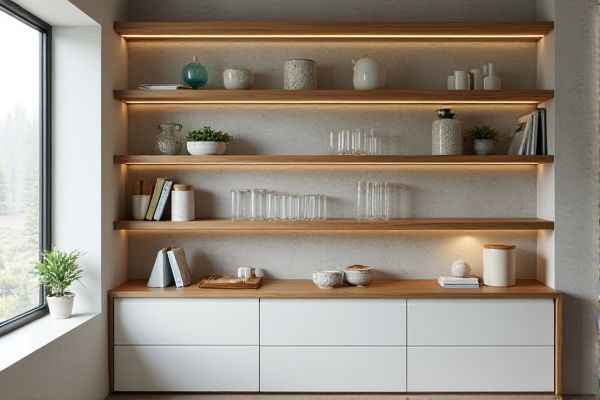
Glass shelves offer a sleek, modern look with a transparent design that maximizes light and creates an open feel, while wood shelves provide warmth, durability, and a classic aesthetic suited for traditional or rustic interiors. Discover how choosing between glass or wood shelves can transform your space by reading the rest of the article.
Table of Comparison
| Feature | Glass Shelves | Wood Shelves |
|---|---|---|
| Material | Tempered or laminated glass | Solid wood or engineered wood |
| Durability | Resistant to moisture, prone to cracking | Strong and sturdy, can warp in humidity |
| Weight Capacity | Moderate, depends on thickness (typ. 8-12mm) | High, supports heavy loads well |
| Maintenance | Easy to clean, requires careful handling | Requires polishing or sealing periodically |
| Aesthetics | Modern, sleek, transparent | Warm, classic, varies by wood type |
| Cost | Generally higher due to material and processing | Varies, typically more affordable |
| Installation | Fragile, needs precise fitting | Simple, flexible to customize |
| Environmental Impact | Recyclable but energy-intensive production | Renewable resource, sustainable with responsible sourcing |
Introduction to Glass and Wood Shelves
Glass shelves offer a sleek, modern aesthetic with transparency that enhances light flow and creates an open space feel, making them ideal for contemporary interiors. Wood shelves provide warmth and durability, available in various finishes and grains that complement traditional and rustic designs. Both materials serve functional storage needs but differ significantly in visual impact, maintenance, and style versatility.
Aesthetic Appeal: Glass vs Wood
Glass shelves offer a sleek, modern aesthetic with their transparent, light-reflecting surfaces that enhance room brightness and create an illusion of space. Wood shelves provide a warm, natural appeal, showcasing rich textures and grain patterns that add character and a timeless, rustic charm to interiors. The choice between glass and wood shelving significantly impacts the overall design style and ambiance of a room.
Strength and Durability Comparison
Glass shelves offer a sleek, modern aesthetic while providing moderate strength suitable for lightweight to medium loads, typically tempered for enhanced durability and resistance to shattering. Wood shelves, especially those made from hardwoods like oak or maple, deliver superior strength and long-term durability, capable of supporting heavier items without bending or warping over time. Choosing between glass and wood shelves depends on load requirements and desired longevity, with wood generally preferred for robust, heavy-duty applications and glass for lighter, decorative uses.
Weight Capacity and Practical Use
Glass shelves typically support less weight than wood shelves due to their brittle nature, making wood a better choice for heavy items or high-traffic areas. Wood shelves offer superior durability and practicality for everyday use, accommodating diverse storage needs without the risk of cracking or breaking. Your decision should balance aesthetic preferences with the specific weight capacity required for your intended use.
Maintenance and Cleaning Requirements
Glass shelves require regular cleaning with non-abrasive glass cleaners to prevent fingerprints and smudges from detracting their transparency, while wood shelves benefit from dusting and occasional polishing to maintain their finish and prevent drying or cracking. Glass is less prone to staining and corrosion compared to wood, which can absorb spills and may need refinishing over time. Your choice depends on whether you prefer low-maintenance clarity or the warm, natural upkeep of wood surfaces.
Customization and Design Flexibility
Glass shelves offer superior customization options with their ability to be cut into various shapes and sizes, allowing for sleek, modern designs that maximize light transmission and create an open, airy feel. Wood shelves provide versatile design flexibility through a wide range of finishes, stains, and woodworking techniques, enabling tailored aesthetics from rustic to contemporary styles. Both materials support personalized shelving solutions, but glass excels in minimalist, visually lighter applications while wood delivers warmth and texture with rich customization potential.
Cost Analysis: Glass Shelves vs Wood Shelves
Glass shelves typically cost more upfront due to materials and manufacturing precision, with prices ranging from $50 to $150 per linear foot, depending on thickness and design. Wood shelves generally offer a more budget-friendly option, costing between $20 and $80 per linear foot, influenced by wood type such as pine, oak, or walnut. Maintenance and durability factors also impact long-term expenses, as glass resists moisture and staining while wood may require refinishing or protection treatments.
Safety Considerations for Shelving Materials
Glass shelves offer a sleek appearance but require tempered or laminated glass to enhance safety and prevent dangerous breakage. Wood shelves provide sturdy support and are less prone to shattering, making them ideal for heavy or sharp objects in your space. When choosing shelving materials, consider their load capacity, risk of injury from breakage, and environmental conditions like moisture or temperature fluctuations.
Environmental Impact and Sustainability
Glass shelves offer higher sustainability due to their recyclability and longer lifespan, minimizing landfill waste compared to wood shelves, which often involve deforestation and carbon emissions during production. Wood shelves sourced from sustainably managed forests can reduce environmental impact but typically require more frequent replacement, increasing resource consumption. Manufacturing glass involves energy-intensive processes, yet the inert nature of glass prevents harmful chemical leaching, enhancing its eco-friendliness over resin-treated or chemically finished wood options.
Best Applications for Glass and Wood Shelves
Glass shelves excel in modern interior designs, ideal for displaying decorative items, collectibles, and in bathrooms due to their moisture resistance and sleek, transparent appearance. Wood shelves are best suited for traditional, rustic, or cozy spaces, providing sturdy support for books, heavier objects, and creating a warm aesthetic with diverse finishes like oak, pine, or walnut. Both materials offer unique advantages depending on factors like load capacity, environmental conditions, and design preferences.
 homyna.com
homyna.com